As people seem to appreciate my series of seasonal posts about Scandinavian Christmas traditions, I thought I would write about the “Jultomte” today.
The Nordic “tomtar” seem to have gone global in recent years: I now see social media posts from far-flung locations featuring them. So let’s clear up some confusion about the Swedish word “tomte” first, because I see many different spellings on social media!
Brief Swedish glossary for the festive season!
Tomt = a plot of land.
Tomte (single tense) = a gnome.
Tomten (definite article is glued to the back of the word) = The tomte.
Tomtar (plural) = two or more of them.
Tomtarna (the tomtar, plural + definite article glued to the back of the word).
Jultomte = the Christmas Tomte (Santa Claus or Father Christmas).
Tomteluva = a red and floppy Christmas hat (often with white trim).
Tomtefar & Tomtemor (Father Tomte and Mother Tomte, used in the sense of Father Christmas and Mother Christmas, for instance warning the children who is about to pay a house visit!)
Tomtenisse or Tomtekarl = other versions of the word/concept Tomte.
The word tomte is derived from the word tomt (plot or piece of land) and it refers to the guardian of this land (and by extension any homestead, farm or barn located on it). The tomte was believed to live in the barn, the hay loft or sometimes under a homestead. It is important to maintain a good working relationship with tomtar: keep a tidy farm, provide excellent care for the animals and leave out food offerings. If people did not do this, it was commonly understood that accidents would occur, the farm would fall into disarray or disrepair, key items would go missing, cattle would fall ill etc. As such they are similar to the “house gods” known and venerated in other locations.
Our own Tomte will receive homemade Christmas porridge and a glass of whiskey tomorrow, on Julafton (Christmas Eve). This is not shop-bought porridge, or indeed “any old porridge”: it is prepared from scratch and served with a generous lashing or real butter (I also sprinkle cinnamon on top! (This is called julgröt (Christmas porridge), also known as tomtegröt (porridge for tomte) in Swedish.
Julgröt or tomtegröt!
There is a strong belief that the person who did all the hard work of clearing or working the land and built the first farm (on a plot of land), often made a post-death choice to stay around and check that everything is run properly. (This is why the words tomt and tomte are related and so similar).
This tomte is popularly depicted as elderly (or even ancient), with a long beard, wearing a “tomteluva”.
In the Revelations of Saint Birgitta (Birgittas Uppenbarelser), it is recorded that, in the medieval period, priests cracked down on the ancient custom of people making offerings to their tompta gudhi or "tomte gods" (gods, or powerful spirits, of house and land). In Christian times this ancestral custom was frowned upon and discouraged (but it never fell completely out of use, especially in rural Sweden).
Tomtar make a frequent appearance in both folklore and fairy tales, here in Northern Europe. They are often depicted in the company of animals and some tales suggest that they mastered the ancient art of shapeshifting. (Meaning that they could shapeshift into an animal and find out through direct experience how humans, on a given homestead, treat animals!)
Our family actively maintains a good relationship with our Tomte and also with the Landvaettir (land wights). By necessity we spend lengthy periods away from our forest house, so we depend on Tomte and his helpers to keep the place safe and orderly!)
GOD JUL! MERRY CHRISTMAS! PRETTIGE KERSTDAGEN!
I try (but sometimes fail) to get out at least one essay a week (sometimes several), due to travel, international teaching commitments and family care responsibilities (our family lives with Alzheimer’s and I have written several posts about that). All artwork shown in Substack posts is my own, unless credited differently! If you would like to see regular posts about about Nordic spirituality and my life as a Forest Witch (and of course short videos of all the wildlife here!), please follow me on Instagram or Facebook, thank you!
Imelda Almqvist, Forest House, Sweden
BIO FOR IMELDA ALMQVIST
Imelda Almqvist is an international teacher of Sacred Art and Seiðr/Old Norse Traditions (the ancestral wisdom teachings of Northern Europe). So far she has written four non-fiction books and two picture books for children. Natural Born Shamans: A Spiritual Toolkit for Life (Using shamanism creatively with young people of all ages) in 2016, Sacred Art: A Hollow Bone for Spirit (Where Art Meets Shamanism) in 2019, Medicine of the Imagination - Dwelling in Possibility (an impassioned plea for fearless imagination) in 2020 and North Sea Water In My Veins (The Pre-Christian spirituality of the Low Countries) was published in June 2022.
The Green Bear is a series of picture book for children, aged 3 – 8 years. The stories and vibrant artwork, set in Scandinavia, invite children to explore enchanting parallel worlds and to keep their sense of magic alive as they grow up.
Imelda has presented her work on both The Shift Network and Sounds True. She appears in a TV program, titled Ice Age Shaman, made for the Smithsonian Museum, in the series Mystic Britain, talking about Mesolithic arctic deer shamanism.
Imelda is currently working on a handbook for rune magicians (about the runes of the Elder Futhark) and on more books in the Green Bear Series. Imelda runs an on-line school called Pregnant Hag Teachings, where all classes she teaches remain available as recordings, which can be watched any time.
Website:
http://www.shaman-healer-painter.co.uk/
YouTube Channel: youtube.com/user/imeldaalmqvist
Online School: https://pregnant-hag-teachings.teachable.com/courses/
Facebook: https://www.facebook.com/imelda.almqvist/
Instagram: https://www.instagram.com/almqvistimelda/
Imelda, Forest House and Forest School, Sweden




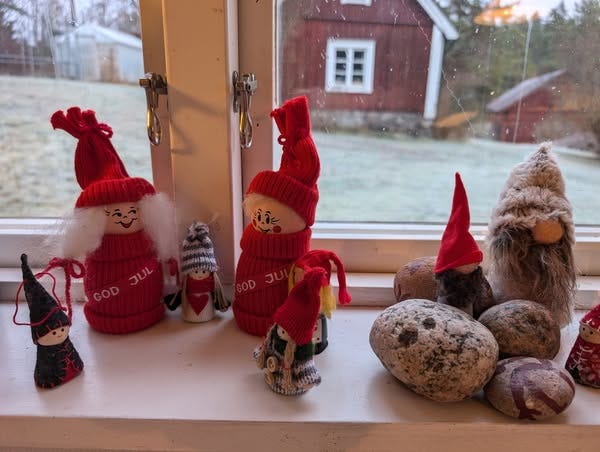
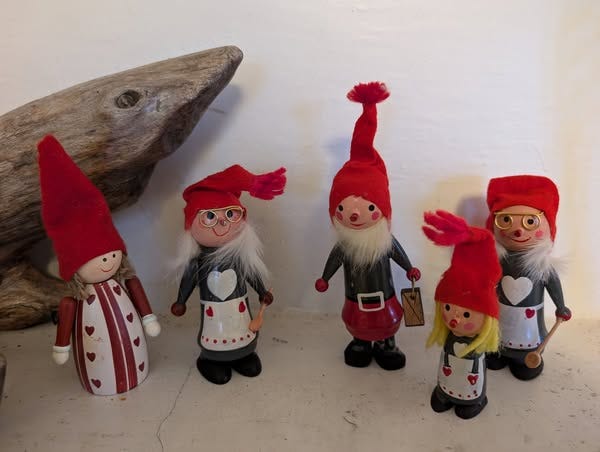
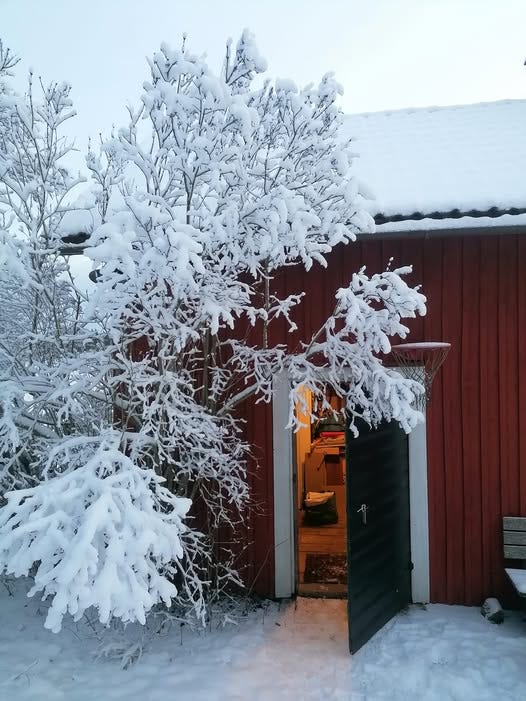
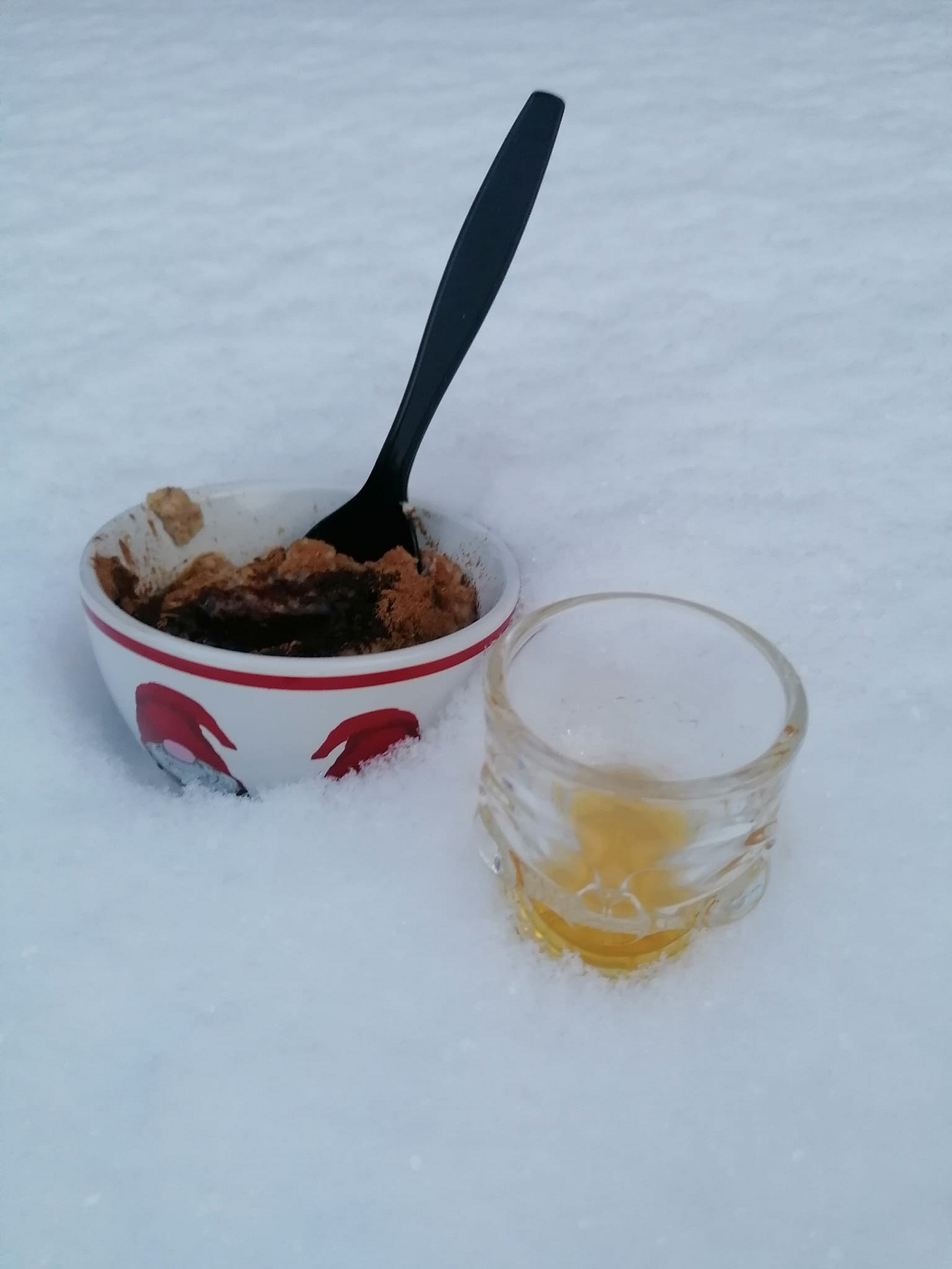
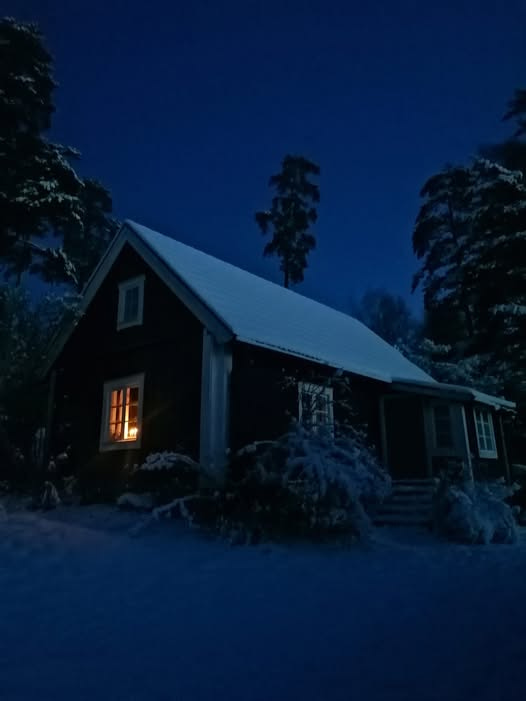

I think you've seen photos of the little wool felt tomtar I made several years ago. I had intended for them to simply be winter holiday decorations, but once I got them set up on the coffee table in the living room, they announced that they are our house spirits! So now they stay there year round, in their own little altar space.
I don’t know if we have tomtar here in Numansdorp but, if so they are very kind.
We moved in here 5 years ago and from the very beginning felt very much welcome and ‘at home.’
And we have been good to the house and the garden. Last weeks the kitchen was renovated and I painted walls and ceiling. ( wearing my Daddy’s white overall. He died at the age of 71 and I am already 4 years older now. This feels strange and he feels close by when I wear this overall.)
Untill now I did not offer anything to the tomtar but I can start doing it. Maybe some jenever instead of whisky 😁.